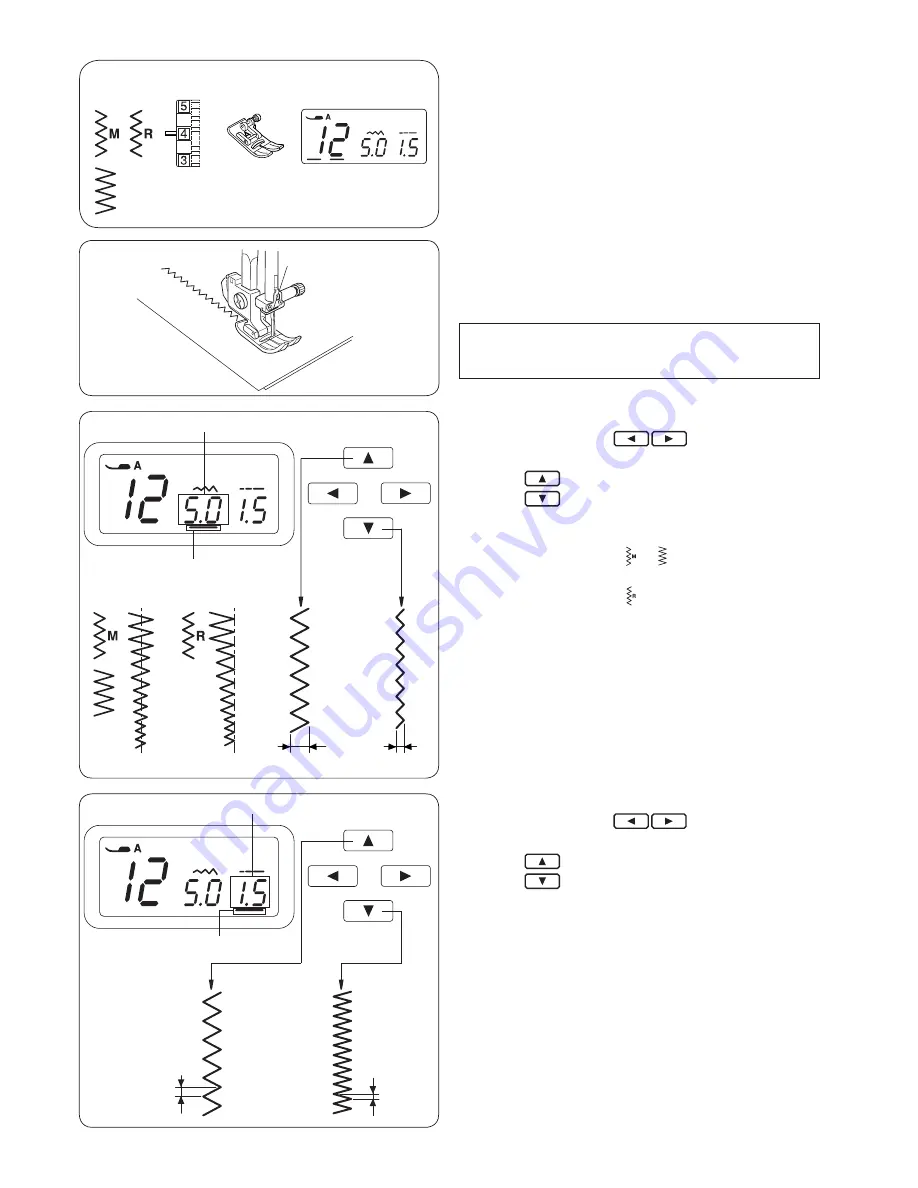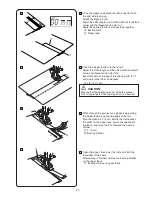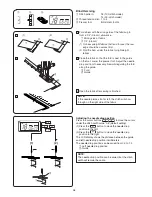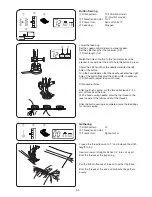
24
④
⑥
④
Zigzag Stitch
①
Stitch pattern:
12 or 13 (100-stitch model)
07 (20-stitch model)
②
Thread tension dial: 3 to 7
③
Presser foot:
Zigzag foot A
Adjusting the stitch width
Press the cursor buttons to move the cursor
①
under the stitch width value “5.0”
②
(default setting).
Press the button to increase stitch width
③
.
Press the button to decrease stitch width
④
.
The stitch width can be varied from 0.0 to 7.0.
The stitch width of pattern or can be changed
without changing its center needle position
⑤
.
The stitch width of pattern can be changed without
changing its right needle position
⑥
.
③
⑤
Adjusting the stitch length
Press the cursor buttons to move the cursor
①
under the stitch length value “1.5”
②
(default setting).
Press the button to increase stitch length
③
.
Press the button to decrease stitch length
④
.
The stitch length can be varied from 0.2 to 5.0.
①
③
①
③
②
00 01 02 03 04 05 06 07 08 09
10 11 12 13 14 15 16 17 18 19
20 21 22 23 24 25 26 27 28 29
30 31 32 33 34 35 36 37 38 39 40 41 42 43
F
F F F F F F A F F F F A F
F F F F F F F F F F F F F F
F F F F F F F F F F F F F F
F F F F F F F F F F F F F F
F F F F F F F F F F F F F F
60 61 62 63 64 65 66 67 68 69 70 71
58 59
44
50 51 52 53 54 55 56 57
45 46 47 48 49
90 91 92 93 94 95 96 97 98 99
86 87 88 89
72 73 74
70 81 82 83 84 85
75 76 77 78 79
00 01 02 03 04 05 06 07 08 09
10 11 12 13 14 15 16 17 18 19
20 21 22 23 24 25 26 27 28 29
30 31 32 33 34 35 36 37 38 39 40 41 42 43
F
F F F F F F A F F F F A F
F F F F F F F F F F F F F F
F F F F F F F F F F F F F F
F F F F F F F F F F F F F F
F F F F F F F F F F F F F F
60 61 62 63 64 65 66 67 68 69 70 71
58 59
44
50 51 52 53 54 55 56 57
45 46 47 48 49
90 91 92 93 94 95 96 97 98 99
86 87 88 89
72 73 74
70 81 82 83 84 85
75 76 77 78 79
00 01 02 03 04 05 06 07 08 09
10 11 12 13 14 15 16 17 18 19
20 21 22 23 24 25 26 27 28 29
30 31 32 33 34 35 36 37 38 39 40 41 42 43
F
F F F F F F A F F F F A F
F F F F F F F F F F F F F F
F F F F F F F F F F F F F F
F F F F F F F F F F F F F F
F F F F F F F F F F F F F F
60 61 62 63 64 65 66 67 68 69 70 71
58 59
44
50 51 52 53 54 55 56 57
45 46 47 48 49
90 91 92 93 94 95 96 97 98 99
86 87 88 89
72 73 74
70 81 82 83 84 85
75 76 77 78 79
②
②
①
The zigzag stitch is one of the most useful and versatile
stitches.
It is used for overcasting, mending, appliqué, and also
used as a decorative stitch.
NOTE:
Use interfacing when sewing on stretch fabrics such
as knit, jersey or tricot.
00 01 02 03 04 05 06 07 08 09
10 11 12 13 14 15 16 17 18 19
20 21 22 23 24 25 26 27 28 29
30 31 32 33 34 35 36 37 38 39 40 41 42 43
F
F F F F F F A F F F F A F
F F F F F F F F F F F F F F
F F F F F F F F F F F F F F
F F F F F F F F F F F F F F
F F F F F F F F F F F F F F
60 61 62 63 64 65 66 67 68 69 70 71
58 59
44
50 51 52 53 54 55 56 57
45 46 47 48 49
90 91 92 93 94 95 96 97 98 99
86 87 88 89
72 73 74
70 81 82 83 84 85
75 76 77 78 79
00 01 02 03 04 05 06 07 08 09
10 11 12 13 14 15 16 17 18 19
20 21 22 23 24 25 26 27 28 29
30 31 32 33 34 35 36 37 38 39 40 41 42 43
F
F F F F F F A F F F F A F
F F F F F F F F F F F F F F
F F F F F F F F F F F F F F
F F F F F F F F F F F F F F
F F F F F F F F F F F F F F
60 61 62 63 64 65 66 67 68 69 70 71
58 59
44
50 51 52 53 54 55 56 57
45 46 47 48 49
90 91 92 93 94 95 96 97 98 99
86 87 88 89
72 73 74
70 81 82 83 84 85
75 76 77 78 79
















































